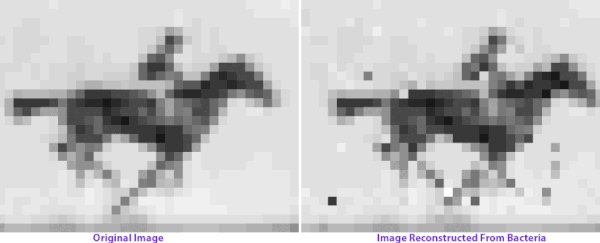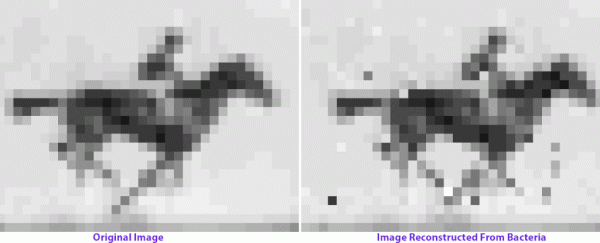One of the earliest motion pictures ever recorded has notched up another impressive first, being encoded into the DNA of living bacteria cells in an ambitious experiment testing the limits of the biological hard drive.
While scientists have stored huge amounts of data (including movies) in DNA before, this represents the first time researchers have encoded and played back a video like this in living bacteria cells – E. coli, no less – but the team involved says this is way more than just a cinematic milestone.
Apart from the spectacle of immortalising this already famous horse flick, researchers say the technique used here could enable living cells to become a real-time "molecular recorder", capturing unseen biological developments inside the body like a kind of organic Digital Video Recorder.
"We want to turn cells into historians," says one of the team, neuroscientist Seth Shipman from Harvard University.
"We envision a biological memory system that's much smaller and more versatile than today's technologies, which will track many events non-intrusively over time."
 Seth Shipman
Seth Shipman
As a neuroscientist, Shipman's interest is in investigating how brain cells change over time. Of course, given that such microscopic developments occur almost imperceptibly inside living tissue, it's not the easiest of things to research – but one way of studying it could be if living cells were somehow able to be co-opted to record the changes themselves.
"There are certain places we can't go that a cell can go," Shipman told Deborah Netburn at the Los Angeles Times.
"The brain is locked away inside the skull, and these changes happen rapidly and all at the same time."
To test the idea, the team converted each shaded pixel of the horse animation into a DNA code – designated by a particular configuration of the DNA nucleobases adenine, guanine, thymine and cytosine.
The researchers then used the gene editing technology CRISPR to embed this sequence of information into the genome of the bacteria E. coli, adding a new frame of animation each day.
The team then waited a week, leaving the bacteria in the lab to divide and multiply, passing the movie on to successive generations as it went – like some kind of biological filesharing process.
Later, after sequencing extracted DNA regions taken from a sample of the bacteria, the team was able to play back the movie with 90 percent of the information still intact – a successful test suggesting that living cells can record and retain information in sequence, which can then be extracted and reviewed if needed.
If that ability can be turned to record other kinds of data – such as changes in gene expression, affecting how neurons and other kinds of cells develop – we might be able to track the development of diseases in real time, or predict the onset of health dangers while they're still preventable.
"If we had those transcriptional steps, we could potentially use them like a recipe to engineer similar cells," Shipman said in a press statement.
"These could be used to model disease – or even in therapies."
The work builds on pioneering research published by the same team last year, which saw them record 100 bytes of data in E. coli.
The new study demonstrates that the living hard drive can be pushed to remember a lot more – and record history in sequence – suggesting that cells could effectively become tiny GoPros inside the body.
Now we just need to figure out how to coerce them to pick up their cameras on our behalf.
The findings are reported in Nature.
